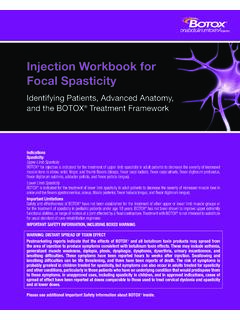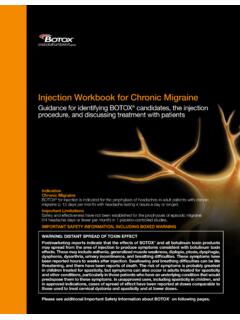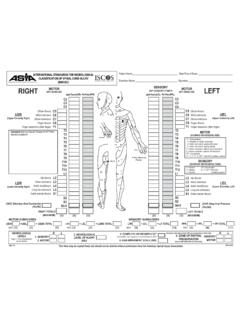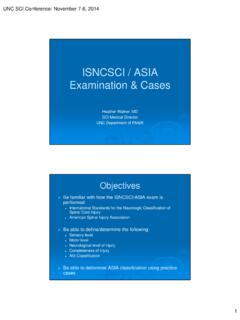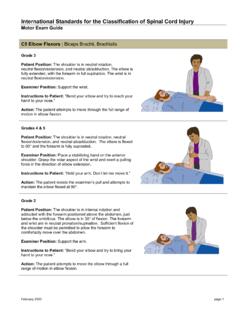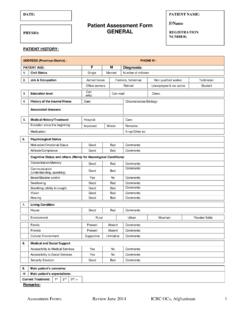Transcription of BOTOX Billing and Coding
1 STREAMLINEIMPORTANT SAFETY INFORMATION, INCLUDING BOXED WARNING WARNING: DISTANT SPREAD OF TOXIN EFFECTP ostmarketing reports indicate that the effects of BOTOX and all botulinum toxin products may spread from the area of injection to produce symptoms consistent with botulinum toxin effects. These may include asthenia, generalized muscle weakness, diplopia, ptosis, dysphagia, dysphonia, dysarthria, urinary incontinence, and breathing difficulties. These symptoms have been reported hours to weeks after injection. Swallowing and breathing difficulties can be life threatening, and there have been reports of death. The risk of symptoms is probably greatest in children treated for spasticity, but symptoms can also occur in adults treated for spasticity and other conditions, particularly in those patients who have an underlying condition that would predispose them to these symptoms.
2 In unapproved uses, including spasticity in children, and in approved indications, cases of spread of effect have been reported at doses comparable to those used to treat cervical dystonia and spasticity and at lower Billing and Codingfor Upper Limb Spasticity, Lower Limb Spasticity, and Cervical DystoniaIndications Spasticity:Upper Limb SpasticityBOTOX for injection is indicated for the treatment of upper limb spasticity in adult patients, to decrease the severity of increased muscle tone in elbow flexors (biceps), wrist flexors ( flexor carpi radialis and flexor carpi ulnaris), finger flexors ( flexor digitorum profundus and flexor digitorum sublimis) and thumb flexors (adductor pollicis and flexor pollicis longus).
3 Lower Limb SpasticityBOTOX is indicated for the treatment of lower limb spasticity in adult patients to decrease the severity of increased muscle tone in ankle and toe flexors (gastrocnemius, soleus, tibialis posterior, flexor hallucis longus, and flexor digitorum longus).Important LimitationsSafety and effectiveness of BOTOX have not been established for the treatment of other upper or lower limb muscle groups. Safety and effectiveness of BOTOX have not been established for the treatment of spasticity in pediatric patients under age 18 years. BOTOX has not been shown to improve upper extremity functional abilities, or range of motion at a joint affected by a fixed contracture.
4 Treatment with BOTOX is not intended to substitute for usual standard of care rehabilitation DystoniaBOTOX is indicated for the treatment of adults with cervical dystonia to reduce the severity of abnormal head position and neck pain associated with cervical see additional Important Safety Information about BOTOX on following see additional Important Safety Information about BOTOX on following is essential to diagnose and code correctly for BOTOX (onabotulinumtoxinA) therapy service(s) to help ensure timely and adequate The descriptor for J0585 requires that BOTOX be billed by number of Units, not number of vials. b For electronic Billing , payers require an 11-digit NDC number (5-4-2 configuration) to be reported on the claim form.
5 Therefore, an additional zero should be added to the beginning of the 10-digit NDC listed on the box (eg, 00023-1145-01).Important codes IMPORTANT SAFETY INFORMATION (continued) CONTRAINDICATIONSBOTOX is contraindicated in the presence of infection at the proposed injection site(s) and in individuals with known hypersensitivity to any botulinum toxin preparation or to any of the components in the AND PRECAUTIONSLack of Interchangeability Between Botulinum Toxin ProductsThe potency Units of BOTOX are specific to the preparation and assay method utilized. They are not interchangeable with other preparations of botulinum toxin products and, therefore, units of biological activity of BOTOX cannot be compared to nor converted into units of any other botulinum toxin products assessed with any other specific assay of Toxin EffectSee Boxed Adverse Reactions With Unapproved UseSerious adverse reactions, including excessive weakness, dysphagia, and aspiration pneumonia, with some adverse reactions associated with fatal outcomes, have been reported in patients who received BOTOX injections for unapproved uses.
6 In these cases, the adverse reactions were not necessarily related to distant spread of toxin, but may have resulted from the administration of BOTOX to the site of injection and/or adjacent structures. In several of the cases, patients had pre-existing dysphagia or other significant disabilities. There is insufficient information to identify factors associated with an increased risk for adverse reactions associated with the unapproved uses of BOTOX . The safety and effectiveness of BOTOX for unapproved uses have not been ReactionsSerious and/or immediate hypersensitivity reactions have been reported. These reactions include anaphylaxis, serum sickness, urticaria, soft-tissue edema, and dyspnea.
7 If such a reaction occurs, further injection of BOTOX should be discontinued and appropriate medical therapy immediately instituted. One fatal case of anaphylaxis has been reported in which lidocaine was used as the diluent, and consequently the causal agent cannot be reliably Risk of Clinically Significant Effects with Pre-Existing Neuromuscular DisordersIndividuals with peripheral motor neuropathic diseases, amyotrophic lateral sclerosis or neuromuscular junction disorders ( , myasthenia gravis or Lambert-Eaton syndrome) should be monitored when given botulinum toxin. Patients with neuromuscular disorders may be at increased risk of clinically significant effects including generalized muscle weakness, diplopia, ptosis, dysphonia, dysarthria, severe dysphagia and respiratory compromise from therapeutic doses of BOTOX (see Warnings and Precautions).
8 Dysphagia and Breathing DifficultiesTreatment with BOTOX and other botulinum toxin products can result in swallowing or breathing difficulties. Patients with pre-existing swallowing or breathing difficulties may be more susceptible to these complications. In most cases, this is a consequence of weakening of muscles in the area of injection that are involved in breathing or oropharyngeal muscles that control swallowing or breathing (see Boxed Warning).Pulmonary Effects of BOTOX in Patients With Compromised Respiratory Status Treated for SpasticityPatients with compromised respiratory status treated with BOTOX for spasticity should be monitored and Upper Respiratory Tract Infections in Patients Treated for SpasticityBronchitis was reported more frequently as an adverse reaction in patients treated for upper limb spasticity with BOTOX (3% at 251-360 Units total dose) compared to placebo (1%).
9 In patients with reduced lung function treated for upper limb spasticity, upper respiratory tract infections were also reported more frequently as adverse reactions in patients treated with BOTOX (11% at 360 Units total dose; 8% at 240 Units total dose) compared to placebo (6%). In adult patients treated for lower limb spasticity, upper respiratory tract infections were reported more frequently as an adverse event in patients treated with BOTOX (2% at 300 Units to 400 Units total dose), compared to placebo (1%).Please see additional Important Safety Information about BOTOX on following see additional Important Safety Information about BOTOX on following Billing CODESTYPECODECODE DESCRIPTORHCPCS IIJ0585aINJECTION, ONABOTULINUMTOXINA, 1 UNITNDC00023-1145-01bBOTOX 100 Unit vial00023-3921-02bBOTOX 200 Unit vial3 Important codes (continued) ICD-10-CM codes submitted to the payer must.
10 Accurately describe the diagnosis for which the patient receives BOTOX (onabotulinumtoxinA) treatment Represent codes at the highest level of specificity (up to 3-7 character codes) Reflect the contents of any clinical notes and/or chart documentation to be included in a Letter of Medical Necessity (LOMN) or prior authorization (PA)CPT codes submitted to the payer must describe the service(s) performed. Please check with your specific payer to determine the use of modifiers. This Coding information contained herein is gathered from various resources and is subject to change. This document is intended for reference only.
